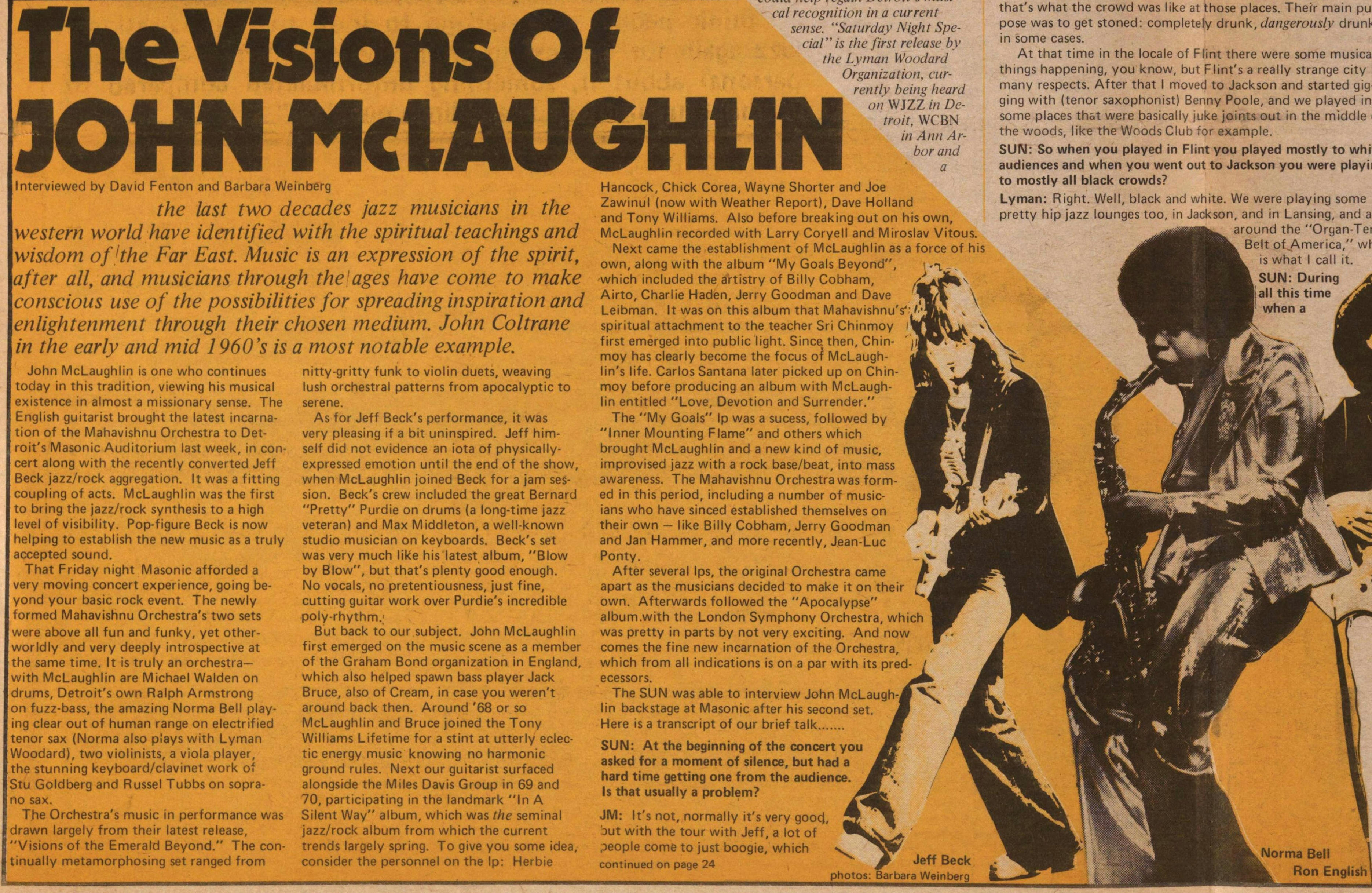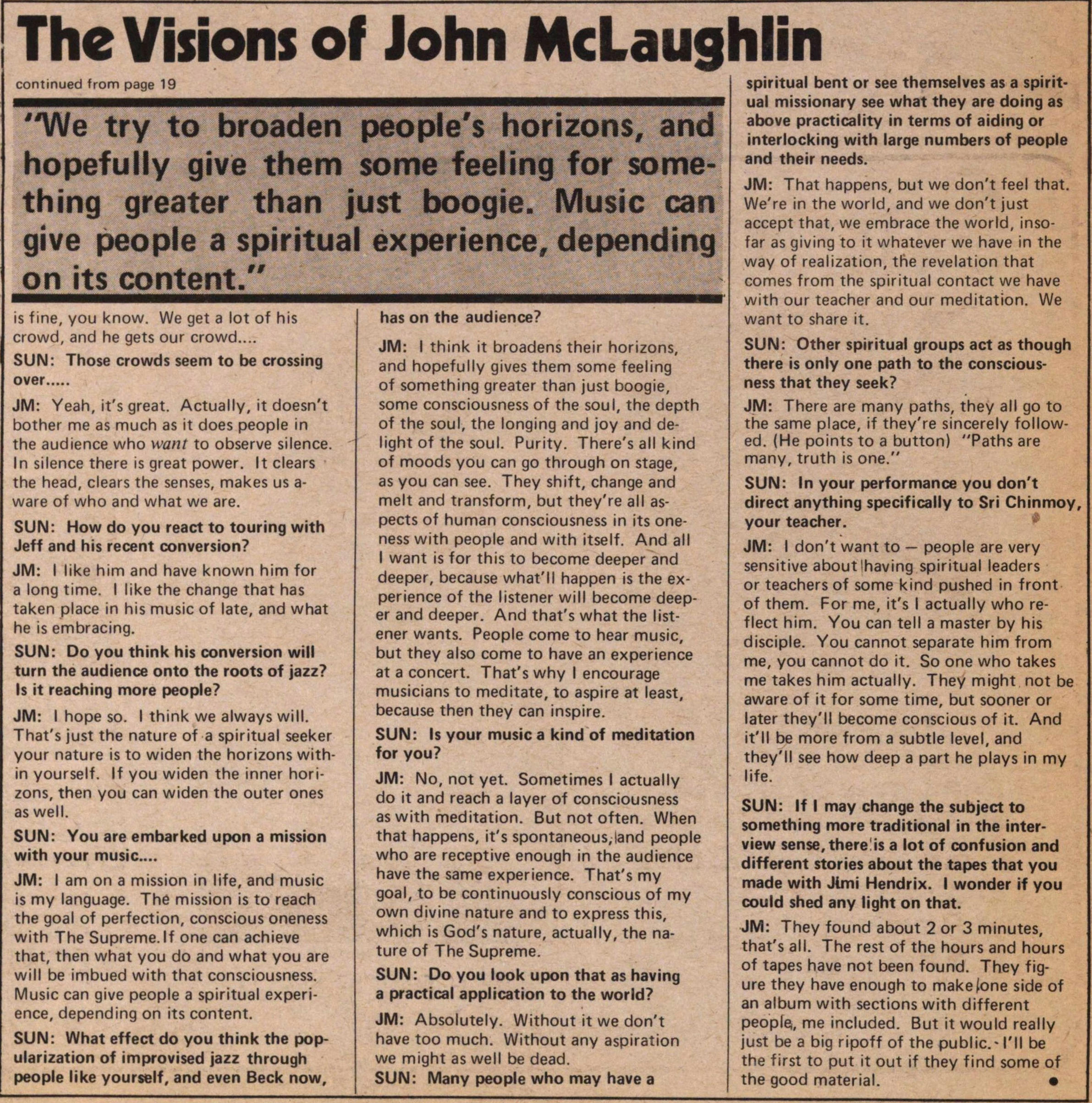The Visions Of John Mclaughlin


The Visions of JOHN McLAUGHLIN
Interviewed by David Fenton and Barbara Weinberg
the last two decades jazz musicians in the western world have identified with the spiritual teachings and wisdom of the Far East. Music is an expression of the spirit, af ter all, and musicians through the' ages have come to make conscious use of the possibilities for spreading inspiration and enlightenment through their chosen medium. John Coltrane in the early and mid 1960's is a most notable example.
John McLaughlin is one who continues today n this tradition, viewing his musical existence in almost a missionary sense. The English guitarist brought the latest incarnation of the Mahavishnu Orchestra to Detroit's Masonic Auditorium last week, in concert along with the recently converted Jeff Beck jazz/rock aggregation. It was a fitting coupling of acts. McLaughlin was the first to bring the jazz/rock synthesis to a high level of visibility. Pop-figure Beck is now helping to establish the new music as a truly accepted sound.
That Friday night Masonic afforded a very moving concert experience, going beyond your basic rock event. The newly formed Mahavishnu Orchestra's two sets were above all fun and funky, yet otherworldly and very deeply introspective at the same time. It is truly an orchestra- with McLaughlin are Michael Walden on drums, Detroit's own Ralph Armstrong on fuzz-bass, the amazing Norma Bell playing clear out of human range on electrified tenor sax (Norma also plays with Lyman Woodard), two violinists, a viola player, the stunning keyboard/clavinet work of Stu Goldberg and Russel Tubbs on soprano sax.
The Orchestra's music in performance was drawn largely from their latest release, "Visions of the Emerald Beyond." The continually metamorphosing set ranged from nitty-gritty funk to violin duets, weaving lush orchestral patterns from apocalyptic to serene.
As for Jeff Beck's performance, it was very pleasing if a bit uninspired. Jeff himself did not evidence an iota of physically expressed emotion until the end of the show, when McLaughlin joined Beck for a jam session. Beck's crew included the great Bernard "Pretty" Purdie on drums (a long-time jazz veteran) and Max Middleton, a well-known studio musician on keyboards. Beck's set was very much like his latest album, "Blow by Blow", but that's plenty good enough. No vocals, no pretentiousness, just fine, cutting guitar work over Purdie's incredible poly-rhythm.
But back to our subject. John McLaughlin first emerged on the music scene as a member of the Graham Bond organization in England, which also helped spawn bass player Jack Bruce, also of Cream, in case you weren't around back then. Around '68 or so McLaughlin and Bruce joined the Tony Williams Lifetime for a stint at utterly eclectic energy music knowing no harmonic ground rules. Next our guitarist surfaced alongside the Miles Davis Group in 69 and 70, participating in the landmark "In A Silent Way" album, which was the seminal jazz/rock album from which the current trends largely spring. To give you some idea, consider the personnel on the lp: Herbie Hancock, Chick Corea, Wayne Shorter and Joe Zawinul (now with Weather Report), Dave Holland and Tony Williams. Also before breaking out on his own, McLaughlin recorded with Larry Coryell and Miroslav Vitous.
Next came the establishment of McLaughlin as a force of his own, along with the album "My Goals Beyond", which included the artistry of Billy Cobham, Airto, Charlie Haden, Jerry Goodman and Dave Leibman. It was on this album that Mahavishnu's spiritual attachment to the teacher Sri Chinmoy first emerged into public light. Since then, Chinmoy has clearly become the focus of McLaughlin's life. Carlos Santana later picked up on Chinmoy before producing an album with McLaughlin entitled "Love, Devotion and Surrender."
The "My Goals" lp was a success, followed by "Inner Mounting Flame" and others which brought McLaughlin and a new kind of music, improvised jazz with a rock base/beat, into mass awareness. The Mahavishnu Orchestra was formed in this period, including a number of musicians who have sinced established themselves on their own - like Billy Cobham, Jerry Goodman and Jan Hammer, and more recently, Jean-Luc Ponty.
After several Ips, the original Orchestra came apart as the musicians decided to make it on their own. Afterwards followed the "Apocalypse" album with the London Symphony Orchestra, which was pretty in parts by not very exciting. And now comes the fine new incarnation of the Orchestra, which from all indications is on a par with its predecessors. The SUN was able to interview John McLaughlin backstage at Masonic after his second set. Here is a transcript of our brief talk......
SUN: At the beginning of the concert you asked for a moment of silence, but had a hard time getting one from the audience. Is that usually a problem?
JM: It's not, normally it's very good, but with the tour with Jeff, a lot of people come to just boogie, which...
continued on page 24
(Image caption)
Jeff Beck
photos: Barbara Weinberg
The Visions of John McLaughlin
continued from page 19
"We try to broaden people's horizons, and hopefully give them some feeling for something greater than just boogie. Music can give people a spiritual experience, depending on its content."
JM:...is fine, you know. We get a lot of his crowd, and he gets our crowd....
SUN: Those crowds seem to be crossing over
JM: Yeah, it's great. Actually, it doesn't bother me as much as it does people in the audience who want to observe silence. In silence there is great power. It clears the head, clears the senses, makes us aware of who and what we are.
SUN: How do you react to touring with Jeff and his recent conversion?
JM: I like him and have known him for a long time. I like the change that has taken place in his music of late, and what he is embracing.
SUN: Do you think his conversion will turn the audience onto the roots of jazz? Is it reaching more people?
JM: I hope so. I think we always will. That's just the nature of a spiritual seeker your nature is to widen the horizons within yourself. If you widen the inner horizons, then you can widen the outer ones as well.
SUN: You are embarked upon a mission with your music...
JM: I am on a mission in life, and music is my language. The mission is to reach the goal of perfection, conscious oneness with The Supreme. If one can achieve that, then what you do and what you are will be imbued with that consciousness. Music can give people a spiritual experience, depending on its content.
SUN: What effect do you think the popularization of improvised jazz through people like yourself, and even Beck now, has on the audience?
JM: I think it broadens their horizons, and hopefully gives them some feeling of something greater than just boogie, some consciousness of the soul, the depth of the soul, the longing and joy and depth of the soul. Purity. There's all kind of moods you can go through on stage, as you can see. They shift, change and melt and transform, but they're all aspects of human consciousness in its oneness with people and with itself. And all I want is for this to become deeper and deeper, because what'll happen is the experience of the listener will become deeper and deeper. And that's what the listener wants. People come to hear music, but they also come to have an experience at a concert. That's why I encourage musicians to meditate, to aspire at least, because then they can inspire.
SUN: Is your music a kind of meditation for you?
JM: No, not yet. Sometimes I actually do it and reach a layer of consciousness as with meditation. But not often. When that happens, it's spontaneous.land people who are receptive enough in the audience have the same experience. That's my goal, to be continuously conscious of my own divine nature and to express this, which is God's nature, actually, the nature of The Supreme.
SUN: Do you look upon that as having a practical application to the world?
JM: Absolutely. Without it we don't have too much. Without any aspiration we might as well be dead.
SUN: Many people who may have a spiritual bent or see themselves as a spiritual missionary see what they are doing as above practicality in terms of aiding or interlocking with large numbers of people and their needs.
JM: That happens, but we don't feel that. We're n the world, and we don't just accept that, we embrace the world, insofar as giving to t whatever we have in the way of realization, the revelation that comes from the spiritual contact we have with our teacher and our meditation. We want to share it.
SUN: Other spiritual groups act as though there is only one path to the consciousness that they seek?
JM: There are many paths, they all go to the same place, if they're sincerely followed. (He points to a button) "Paths are many, truth is one."
SUN: In your performance you don't direct anything specifically to Sri Chinmoy, your teacher.
JM: I don't want to - people are very sensitive about 'having spiritual leaders or teachers of some kind pushed in front of them. For me, it's I actually who reflect him. You can tell a master by his disciple. You cannot separate him from me, you cannot do it. So one who takes me takes him actually. They might not be aware of it for some time, but sooner or later they'll become conscious of it. And it'll be more from a subtle level, and they'll see how deep a part he plays in my life.
SUN: If I may change the subject to something more traditional in the interview sense, there! is a lot of confusion and different stories about the tapes that you made with Jimi Hendrix. I wonder if you could shed any light on that.
JM: They found about 2 or 3 minutes, that's all. The rest of the hours and hours of tapes have not been found. They figure they have enough to make(one side of an album with sections with different people,, me included. But it would really just be a big ripoff of the public. I'll be the first to put it out if they find some of the good material.
Article
Subjects
Freeing John Sinclair
Old News
Ann Arbor Sun